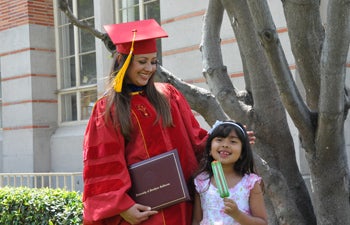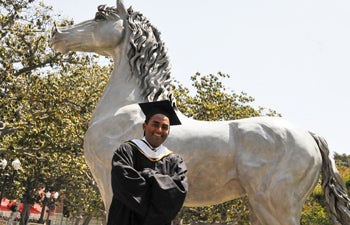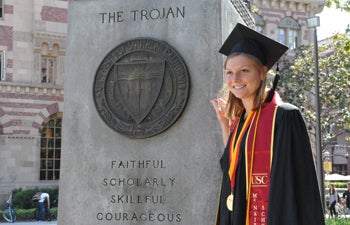Going Places
Emir Estrada opened an envelope she had just picked up from her campus mailbox. The return address said the University of Connecticut.
“Let’s read this together,” said Estrada, who on May 11 earned her Ph.D. in sociology in USC Dornsife.
Dear Miss Estrada,
We’re pleased to offer you a tenured position as assistant professor in the Department of Sociology with a joint appointment in the Center for Latin American and Caribbean Studies beginning on August 23, 2012.
“Oh great!” said Estrada, who had already been notified by phone. “This will give me time to attend my niece’s quinceañera.”
Estrada’s family could not afford to throw her a quinceañera in Zacatecas, Mexico. At 17, she immigrated to Los Angeles with nothing but a few clothes, her high school yearbook and a heart-shaped ring her father Salvador had given her shortly before he suffered a stroke and died.

Emir Estrada, who after immigrating to the United States at age 17 worked cleaning houses with her mother Leonor, conducted research on children working with their immigrant parents as a Ph.D. student in sociology in USC Dornsife. After graduating May 11, Estrada will join the University of Connecticut as an assistant professor. Estrada is raising her 6-year-old daughter Xitlali as a single mother. Photo by Pamela J. Johnson.
A respected maestra — or teacher — in Mexico, Estrada’s mother, Leonor, now cleaned houses to pay the rent. The only English Estrada knew at this point were the words to Bon Jovi songs. She joined her mother in house cleaning.
After taking English classes, Estrada got involved in Extended Opportunity Programs and Services — a financial aid program of the state of California and community college districts — attended Long Beach Community College and transferred to UCLA. In a sociology class, she read Doméstica: Immigrant Workers Cleaning and Caring in the Shadows of Affluence (New edition, University of California Press, 2007) written by Pierrette Hondagneu-Sotelo.
“This is my mom,” Estrada thought as she read the book. “This is me. These are people I know. The book made me feel that I had a place in sociology. It made me for the first time truly feel that I had a space in academia.”
When Estrada learned Hondagneu-Sotelo was a professor of sociology in USC Dornsife, she attended one of her talks and stayed after to meet her.
“I felt like a total groupee,” Estrada recalled. “I was so nervous.”
She told Hondagneu-Sotelo about her interest in studying children of immigrants who work with their parents. Hondagneu-Sotelo encouraged Estrada to apply to USC Dornsife. Working with Hondagneu-Sotelo, Estrada’s paper on Latino adolescent street vendors in Los Angeles has been published in several academic journals.
“I’m happy I completed the doctoral program in five years, despite the bumps,” Estrada said. By bumps, she’s referring to a difficult divorce and raising her 6-year-old daughter, Xitlali, as a single mother.
She knew how far she had come when after giving a talk about her research on children street vendors, a student approached her.
“She told me that as a child, she used to be a street vendor,” Estrada said. “My study had inspired her to conduct her own research.”
One Step Closer
His wife more or less dragged him there. Krishna Narayanamurti dutifully placed a foot on a step that led up a mountain to the Tirumala Temple in India. He looked at the number on the step: 100.
Only 3,900 more to go.
“This is ridiculous,” he thought. “What a waste of time.”
Once at the temple, Narayanamurti resisted rolling his eyes at the 8-foot tall statue of a gold-adorned Lord Venkateswara, whose devotees believe embodies the living spirit of God.
But those black granite eyes sucked him in.
“I really felt that the statue was looking at me,” Narayanamurti recounted. “I know it sounds insane. The statue was drawing me in with its eyes.”
The cynical side of him softened.
“Maybe there’s something behind this mythology,” he thought. “It made me delve into Hinduism in a serious way for the first time.”

Krishna Narayanamurti, a graduate of USC Dornsife’s Master of Professional Writing program, is one giant step closer to publishing his memoir 4,000 Steps to God. Photo by Pamela J. Johnson.
Narayanamurti, who graduated May 11 with a degree in USC Dornsife’s Master of Professional Writing program, has written 120 pages of his memoir, 4,000 Steps to God. The program kick started Narayanamurti’s writing career. A multimedia producer at California State University, Northridge, he knew he had a book in him and the program helped him to access it.
More than a memoir, the book is a spiritual journey. It’s a different take on the bestselling memoir Eat Pray Love, he said. This journey is from the perspective of a United States-born Indian returning to India. In the book, he talks about the four paths of yoga — karma (selfless service), bhakti (devotion to God), raja (renunciation) and jnana (knowledge).
“You have to blend all four types of yoga in your life, not just focus on one,” Narayanamurti said. “That has been one of my discoveries.”
Narayanamurti, a first-generation Indian American, was born in New Jersey to physicist father Venky and child psychologist mother Jaya. His family moved to New Mexico during his middle school years before settling in Santa Barbara, Calif. He earned his bachelor’s in film and studied theater at the University of California, Santa Barbara.
Wanting to write, he researched master’s programs.
“I knew if I wanted to pursue the creative arts, I had to just go for it,” he said. “MPW was the only program I could find that had a multi-genre approach.”
While a student, Narayanamurti partnered with PEN Center USA’s PEN in the Classroom residency program, going into local high schools and teaching a multi-genre writing course.
“People often say, ‘I’m a writer,’ but they don’t have anything to show for it,” Narayanamurti said. “Now I have the actual pages.”
Surfers Rule
Mariah Gill and her two sisters were infants the first time their father took them surfing. Living in Southern California for the past four years, Gill surfs on a regular basis. Her hair, the color of ripened wheat, was still damp from an early morning surf at El Porto Beach in El Segundo.
Back home in Lahaina, Hawaii, 21-year-old Gill’s mother Margo tends to the 120 chickens and six goats at the family farm. Her father Damon worked his way up at a county water treatment plant from groundskeeper and is now an officer overseeing the water quality.
You almost don’t need to ask.
“More than anything,” Gill replies when asked if she misses Maui. But now Gill, who graduated May 11 with a bachelor of science degree in environmental studies from USC Dornsife, will venture to a place where “bundle up” replaces “surf’s up.”

Mariah Gill, a USC McNair Scholar, first-generation college student and avid surfer, will pursue her master’s degree at Yale University. She obtained her bachelor’s degree in environmental studies in USC Dornsife. Photo by Pamela J. Johnson.
The first-generation college student is Yale University-bound. She’ll be earning her master’s degree in environmental management.
“This is a whole new adventure,” Gill said. “I’ve never been in freezing weather so it’s going to be crazy. I’m treating it as if I’m going to visit another country.”
As a McNair Scholar, her research involved looking at the planning process of a marine protected area off the coast of Malibu and news reports about community sentiment on the issue.
She also took advantage of USC Dornsife’s Summer Undergraduate Research Fund (SURF) and Student Opportunities for Academic Research (SOAR). Through these programs she studied community-based research management. The management style involves community members in researching and developing solutions to local problems such as establishing fishery protection zones. Gill’s geographic area of study is fisheries in Maui.
Growing up in an island paradise, Gill feels strongly about protecting the environment.
It took her awhile to figure out that her heart lay in studying how people affect the environment rather than environmental engineering. Seeing herself someday designing water treatment facilities, she entered USC as a student at the Viterbi School of Engineering.
“I learned that chemistry and math were not my style,” she said.
In her sophomore year, she visited Jim Haw, USC Dornsife’s environmental studies program director.
“I was a little lost,” Gill recalled. “I told him I didn’t see myself as an engineer. I didn’t see myself wearing a suit all my life. He said, ‘Why don’t you join our program.’ ”
Haw — Ray R. Irani Chairman of Occidental Petroleum, chair in chemistry and professor of chemistry and environmental studies — placed Gill in the Problems Without Passports program’s first environmental studies course in Guam and Palau, where she scuba dived while researching biodiversity.
“Why not continue my research on the East Coast?” she said.